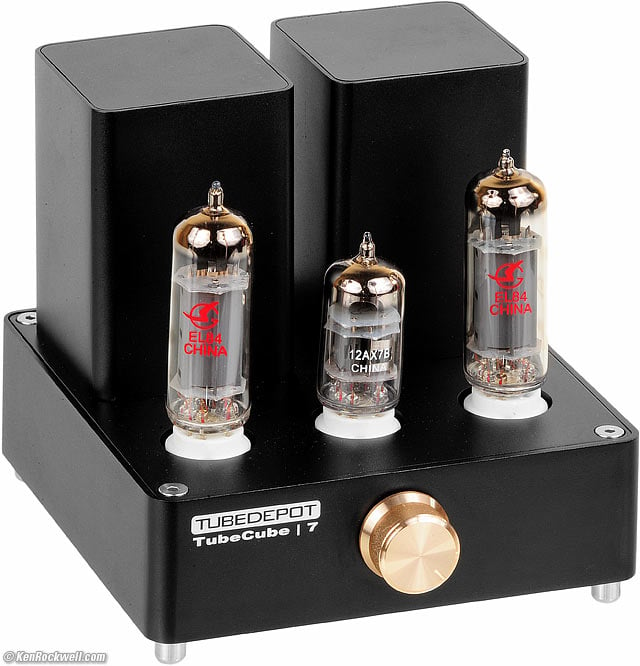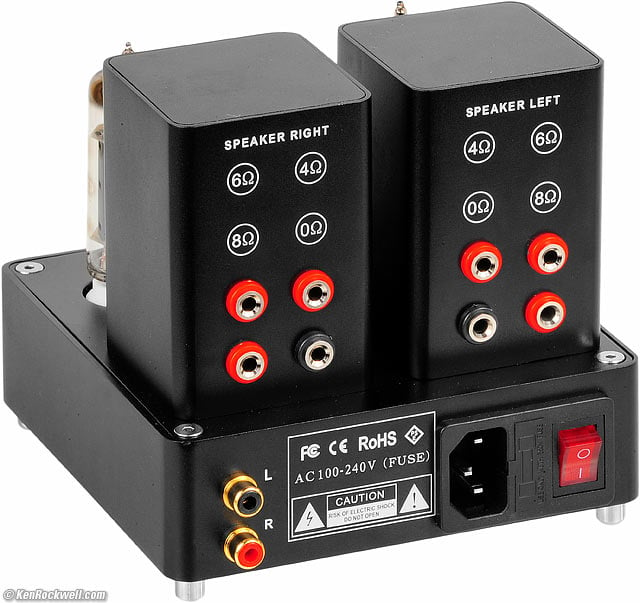Home Donate New Search Gallery Reviews How-To Books Links Workshops About Contact
TubeDepot TubeCube | 7
3.5 WPC Stereo Tube Amplifier (2015-)
© 2015 KenRockwell.com. All rights reserved.
Intro Specifications Measurements Usage Recommendations
TubeCube | 7 (rated 3.5 watts per channel, 4.17 lbs./66.75 oz./1,890g, measured 35 watts power draw, $179.95). enlarge.
This all-content, junk-free website's biggest source of support is when you use any of these links to approved sources when you get anything, regardless of the country in which you live. Buy only from the approved sources I use myself for the best prices, service, return policies and selection. Thanks for your support! Ken.
Rear, TubeCube | 7. enlarge.
March 2015 audio reviews tube reviews all reviews
NEW: Why Tubes Sound Better 27 May 2015
Introduction top
Intro Specifications Measurements Usage Recommendations
The TubeCube | 7 from TubeDepot is an adorable little vacuum tube power amplifier. It's only the size of a CD jewel box!
It's a real tube amplifier at a give-away price. It's not a crappy hybrid with tubes that aren't even connected; this little gem is the real thing with a 12AX7B driving two EL84s.
As we expect from tubes, this amplifier gives incredibly smooth and liquid sound. Once you've heard voices and piano through this amp, you may be throwing away your solid-state amps very quickly.
It has all the expected characteristics of tube amps: liquid sound, and high output impedance. Its actual frequency response will change depending on your choice of speaker.
Look out: for only $179.95 this is a steal, but it sounds so good that if this is your first tube amp, you'll quickly think if this little one sounds great, you'll want to drop many thousands on grown-up tube amps next.
The reason it only seems to have two, not three, big transformers is another treat: it has a modern switching power supply that lets it work perfectly at any random or varying voltage from 100 VAC to 240 VAC. This modern power supply weighs much less because it no longer needs the huge third power transformer that old-style analog power amps required. It also gives better performance, with the same regulated outputs regardless of inputs, brownouts or poor house wiring, and it drives the heaters with DC, not AC, so there's much less room for any hum. I tested it from 100 ~ 135 VAC, and saw no difference in heater brightness, power consumption, distortion or power output. This little jewel is completely immune to power supply variance, which few if any audio power amplifiers are.
It sounds fantastic. As a real tube amp, its sound is all that we expect for tubes: indescribably smooth and warm sound.
It has very little power output and is intended for desktop use. That's what you get for your $180. It's very well made and high on quality, but you won't get the power output of a grown-up American tube amp as you will from Manley or VTL.
Something else Manley, McIntosh and VTL can't do is offer a 6Ω tap. This little amp has taps for 4Ω, 6Ω and 8Ω, which is great because many 8Ω speakers are really closer to 6Ω.
What can you do with 3.5 watts per channel? 90% of what you do with a 1,000 W amplifier! No, it doesn't go loud, but calm down and it sounds amazing. I come from a musician's background; I listen at live levels, while audiophiles usually listen so softly that this will have plenty of power. For most pop music today that's dynamically compressed beyond recognition it goes plenty loud on a desktop, but for real music with a full dynamic range, peaks may go splat! if you turn it up too far in a room.
I run mine on my desk with a pair of B&W Matrix 805 on two pairs of AudioEngine stands, for which it has more than enough output. Of course my speakers are just 28" (70cm) from each ear and I use a low-level active crossover to drive them only above 40 Hz, with the bass handled by a stereo pair of B&W ASW 800 subwoofers, but that's just me.
I also drove a pair of 4Ω B&W Matrix 802 Series III with this little amp, and as I expected, it improved the sound of the speakers. I run my 802 also in the near-field, only 29"/75cm from each ear, and they are way too bright when listened to that close. This TubeCube 7 has a slight rolloff at the top, which perfectly complements the excess brightness of my 802s.
The few dB rolloff at the top contributes to the smooth sound of this amp, but it also means that while it's as smooth as melted butter, it won't have quite the detail of fancier tube amps.
It's ultra smooth, but only semi-sweet due to a lack of the very upper end. It takes the edge off your speakers and source material, which is fantastic for bright speakers.
Bass sounds swell driving the B&W 802s, but if you get too excited and crank it up, the deepest bass will start punching holes in the rest of the music (distorting). No worries, I also use a low-level active crossover with my 802s to send everything below 40 Hz to a pair of B&W ASW 850 subwoofers, and all is well.
With only 3.5 watts, it plays normal things great, but if you ask it to reach for anything loud, it will go blat. With pop music's limited dynamic range it's rarely a problem, but with real music like a Rachmaninoff piano concerto, you'll have to duck the levels to keep the peaks from distorting. This is in my arm chair with the 802s; there's plenty of level with my 805s on my desk.
I measure about 7 watts peak (RMS equivalent) from the 4Ω taps delivered to my 4Ω 802s without any distortion, which is much more than I measured steady state.
It's microphonic: when tested into dummy loads in the lab, the transformers make sound, and playing test tones through speakers you may hear the innards of the tubes rattling. This is normal.
Its all-metal casing feels pretty tough. It feels almost as tough as a Woo Audio WA7. Nothing wiggles or rattles; it's a tough little block of precision.
Specifications top
Intro Specifications Measurements Usage Recommendations
Tubes
(2) Shuguang EL84.
(1) 12AX7B.
Output Transformers
Japan Z11-EI48*24.
Output Power
3.5 WPC.
Output Connections
Taps for 8Ω, 6Ω and 4Ω.
Banana jacks only.
8Ω tap at standard 3/4" spacing.
6Ω and 4Ω taps at non-standard spacing.
Frequency Response
30 Hz - 40 kHz ± 1 dB.
Noise
80 dB below 3.5W.
< 1mV AC.
Input Impedance
50 kΩ.
Input Sensitivity
500 mV.
Quality
Made in China.
Packaging
Corrugated cardboard box.
Supported solidly by two pieces of closed-cell white foam.
Power Input
100~240 VAC, auto adjusting.
Rated Power Consumption
38 W.
2A internal fuse.
See also Actual Power Consumption.
Size
5.1" (130 mm) cube.
Weight
4.17 lbs. (66.75 oz. or 1,890 g), actual measured net weight, with tubes.
2.6 kg rated, probably gross shipping weight.
Price, USA
March 2015: $179.95.
Measurements top
Intro Specifications Measurements Usage Recommendations
As expected, tube gears measures horribly. It shows how meaningless most lab measurements are — and these measurements tell me this is a real tube design, not a crummy hybrid.
These measurements are made with an exotic Rohde & Schwarz UPL laboratory analyzer. The traces from the Rohde & Schwarz UPL laboratory analyzer are color coded for the Left Channel and for the Right Channel. When they don't lie on top of each other, it's due to channel imbalance. When they do lie on top of each other, the trace turns blue.
Unless otherwise specified, all measurements are RMS at 1 kHz at 1 V into 8Ω from the 8Ω tap, both channels driven. I used a 120 VAC supply voltage, and saw no differences when measured anywhere between 100 and 135 VAC.
Input Level Gain Channel Balance
Frequency Response Distortion Noise
Input Level measurements top
430 mV RMS for 1 W output.
Gain measurements top
16.373 dB left, 16.589 dB right, at VOLUME MAX.
9 dB with volume at 12 o'clock; it's a linear taper pot.
-30 dB before it cuts off completely at about 7 o'clock.
Channel Balance measurements top
Channel balance is very good.
At maximum, the right channel is 0.17 dB hotter than the left.
The right channel reaches a maximum of about 0.4 dB hotter than the left at about the 11 o'clock setting of the volume control.
Frequency Response measurements top
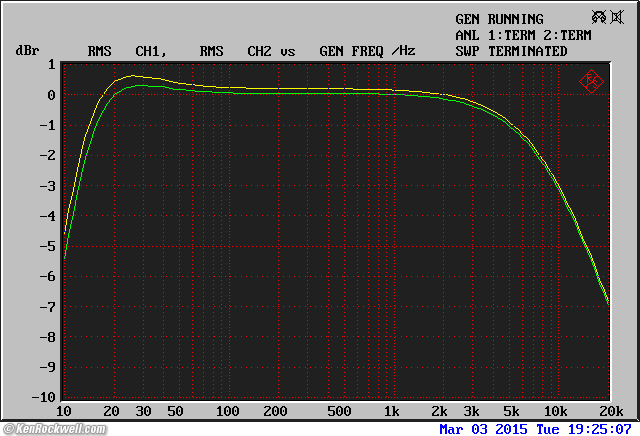
Frequency response.
Bass response is superb, but oddly the high end is rolled off by 3 dB at 10 kc and rolls off at about 4 dB/octave above that.
I see +0.2, -3 dB from 18-10,000 Hz.
This contributes to the darker, warmer sound of this amplifier, which is what people expect for a tube amp. Sorry, if you want flatter, use an EQ or pay twenty times as much for a Manley.
Distortion measurements top
While my measurements may look otherwise, when actually used to enjoy music, it's clean right up to the point of distortion. There is a pretty audibly obvious point above which musical peaks distort.
As expected for a tube amp, even though it easily puts out over 5 WPC RMS peak measured while enjoying music, no way can it put out 3.5 WPC steady state sine-wave at any reasonable distortion level:
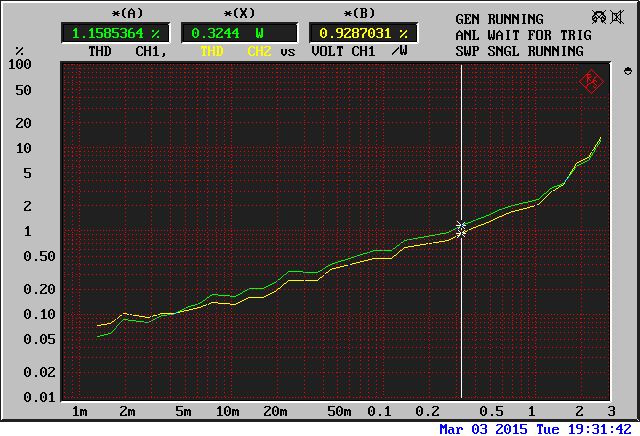
THD versus power.
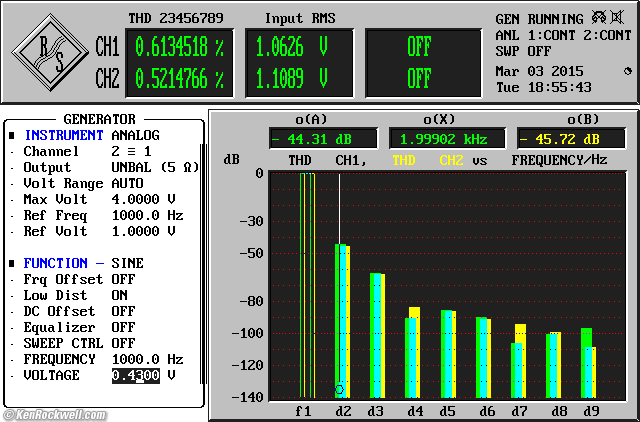
Harmonic distortion content at 1V (125 mW) output.
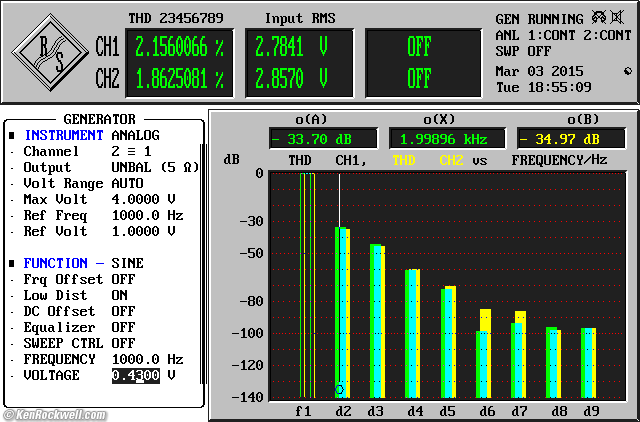
Harmonic distortion content at 1 watt (2.828 V output).
THD is mostly second-order, as we expect for a tube amp.
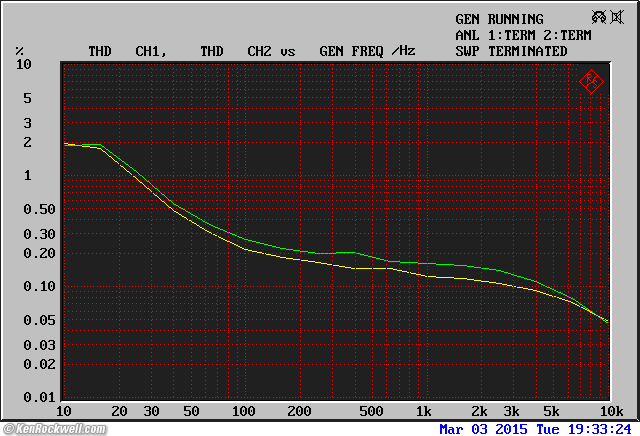
Harmonic distortion versus frequency at 10 mW output.
Even at low levels, low-frequency THD is high.
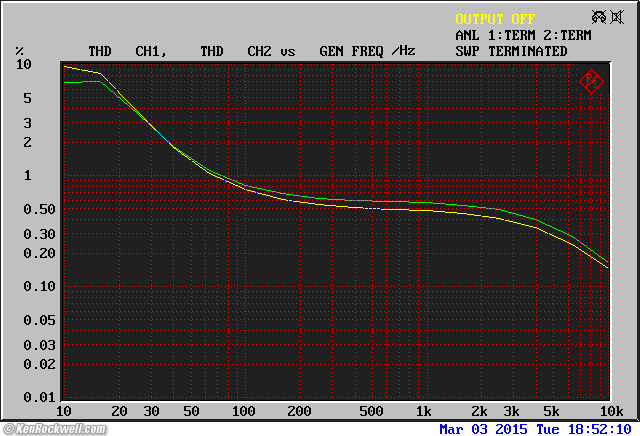
Harmonic distortion versus frequency at 1V (125 mW) output.
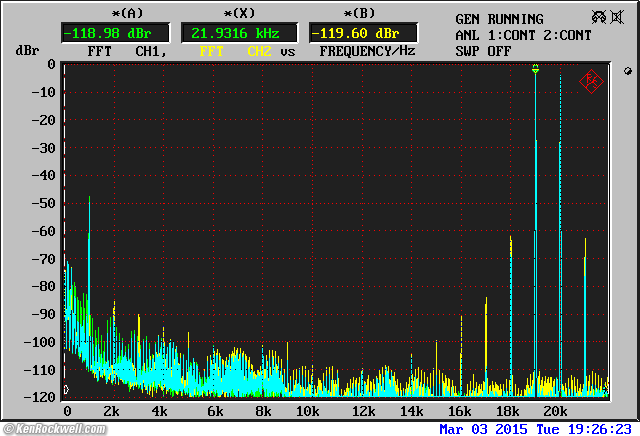
19 + 20 kc difference-frequency distortion at 1V (125 mW) output.
Output Noise measurements top
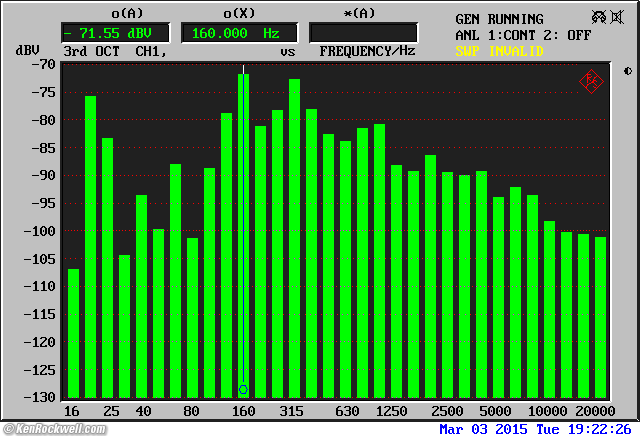
Output noise spectrum.
A Weighted |
Unweighted 22kc BW |
|
MAX |
-75 dBV A |
-69 dBV |
MIN |
-78.3 dBV A |
-70.3 dBV |
This is worse than solid state, but still silent even at close range.
It's still quieter than the Musical Fidelity M1PWR, ha!
Actual Power Consumption measurements top
My TubeCube 7 draws 34.5 watts regardless of output level or supply voltage.
It gets perfectly warm: nice and cozy, but never too hot to touch the metal case. (Never touch hot tubes!)
Usage top
Intro Specifications Measurements Usage Recommendations
It's so easy to use it doesn't even bother with an instruction sheet!
Feet
It has no feet; only bare metal nubs.
Put it on cardboard or a magazine when you get it so you don't damage your furniture.
Later, get some thick stick-on rubber bumpers.
Power
Use any standard IEC or HP power cord.
There is no power cord included; the world already has more than enough power cords.
There's no need for anything fancy; any old computer power cord is what studio professionals use, especially for an amp like this that is completely immune to AC power supply variations.
The power switch is upside down for the USA; DOWN is ON.
Connections
Use a standard 3/4" spaced dual banana MDP plug for the 8Ω output.
For the 6Ω or 4Ω output, you'll need to use single banana plugs.
Always use insulated plugs, never metal ones that can be accidentally shorted.
NEVER run the amplifier without speakers connected. Running a tube amp with nothing connected to it is the best way to destroy it; tube amps do not like being run into open circuits.
Warm Up
Let the amp warm up for about a minute before you start beating on it.
When turned on, the tubes start glowing in about 7 seconds and music starts after about 25 seconds.
Level Control
Leave it all the way up if driving this from a preamp or other volume-controlled source.
If connected directly to a CD player, DAC, iPhone, AirPort Express or the analog output of a computer, leave that level all the way up and control it from the amp's own control.
Feet
I don't like the hard all-metal nubs that pass as feet.
They are easy to unscrew, and once unscrewed, I stuck a set of 3M 3/4" peel-and-stick rubber bumpers in their place.
Biamplification
I use an active crossover so that only the upper frequencies are passed to this amplifier and my main speakers. The crossover feeds the lows to my stereo subwoofers, excusing this baby amplifier from needing to provide that power.
This is a classic win-win situation and why all pro systems are multi-amplified: by sending the lows to the amplifiers in the subwoofers, this tiny main amp has less work to do.
By excusing this amp from having to power the lows, it can work its magic on everything else with none of the strain of having to power the bass as well.
Electrostatics
I haven't tried this with my Quad ESL-63, because if I did I'd probably never stop listening to it. Especially if you biamplify to let this amp play louder, it ought to be ideal for use with electrostatics — but I haven't tried it yet.
Monoblock operation (for engineers ONLY)
There is no MONO mode, but here's how I'd do it.
DO NOT try this unless you are an electrical engineer skilled in analog circuit design.
I haven't tried this, so good luck. This should let you get two amps for a whopping $360 and get 5 to 7 watts per channel.
Completely unlike solid-state stereo amps that are run in bridge mode for mono, tube amp outputs are connected in parallel for mono, taking advantage of their finite output impedances to keep them from blowing up.
For each channel:
1.) Use an RCA Y-cord to feed both channels the same input.
2.) Use the 8Ω outputs.
3.) Use two more MDP plugs connected together with a short length of zip cord to short both outputs together (connect them in parallel).
4.) The 8Ω outputs paralleled together will now drive a 4Ω load to about twice the power as one channel would. (Normally we use the 16Ω outputs for driving 8Ω in mono, but this amp has no 16Ω taps.
5.) If you use different plugs, the 6Ω outputs in parallel should be happy driving a 3Ω load, and the 4Ω outputs in parallel should be happy driving a 2Ω load.
6.) Only connect the same taps together (6Ω to 6Ω for instance), never connect different taps together.
7.) Repeat for the other channel.
Recommendations top
Intro Specifications Measurements Usage Recommendations
I had no idea how much I was going to like my TubeCube | 7.
It's tiny, so it's a joy to move around and connect. it's so easy to use and sounds so good you'll want a few of them.
It's stable and works great.
It's the real thing, a real tube amp and not a solid-state hybrid. It has all the qualities we expect from tube amps of any price, just not with the high price or high power.
If you keep your levels reasonable, this is a super-inexpensive way to see just why tube gear is held in such high regard. Plug it in and listen, the difference is obvious. Tube gear, and especially inexpensive but good gear like this, adds euphonic distortions to the sound that many people prefer to the clean, cold output of solid state amps.
Most top albums are recorded with microphones that use tube pre-preamps inside their cases and then use outboard tube preamps just before being fed to an ADC to be recorded digitally. Tubes just sound better.
Enjoy!
Help me help you top
I support my growing family through this website, as crazy as it might seem.
The biggest help is when you use any of these links when you get anything, regardless of the country in which you live. It costs you nothing, and is this site's, and thus my family's, biggest source of support. These places have the best prices and service, which is why I've used them since before this website existed. I recommend them all personally.
If you find this page as helpful as a book you might have had to buy or a workshop you may have had to take, feel free to help me continue helping everyone.
If you've gotten your gear through one of my links or helped otherwise, you're family. It's great people like you who allow me to keep adding to this site full-time. Thanks!
If you haven't helped yet, please do, and consider helping me with a gift of $5.00.
As this page is copyrighted and formally registered, it is unlawful to make copies, especially in the form of printouts for personal use. If you wish to make a printout for personal use, you are granted one-time permission only if you PayPal me $5.00 per printout or part thereof. Thank you!
Thanks for reading!
Mr. & Mrs. Ken Rockwell, Ryan and Katie.
Home Donate New Search Gallery Reviews How-To Books Links Workshops About Contact

